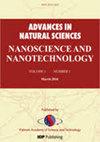Synthesis, evaluation, and monitoring of red amaranth extract for power production
IF 2.1
Q3 MATERIALS SCIENCE, MULTIDISCIPLINARY
Advances in Natural Sciences: Nanoscience and Nanotechnology
Pub Date : 2024-01-16
DOI:10.1088/2043-6262/ad1a9f
引用次数: 0
Abstract
The scientific paper describes the synthesis of silver nanoparticles (Ag NPs) using a fresh red amaranth preparation and explores their potential to enhance the output current of a red amaranth bio-electrolytic cell. The study employed various analytical techniques such as x-ray diffraction (XRD), Fourier transform infrared (FTIR), ultraviolet-visible spectroscopy (UV–vis), dynamic light scattering (DLS), and Raman spectroscopy to characterise and detect the nanoparticles. The UV–vis analysis of the dripping media containing silver nanoparticles exhibited an absorption peak, indicating the presence of the nanoparticles. FTIR was utilised to examine the interaction between the biomaterial components and the oxidation and wrapping of silver nanoparticles. XRD analysis revealed that the synthesised nanoparticles possessed a naturally columnar shape and a face-centered cubic (FCC) structure. The average size and morphology of the nanoparticles were characterised by dynamic light scattering (DLS). Raman spectra revealed the unique surface-enhancing properties of synthesised Ag NPs. The research presented in the paper highlights the remarkable performance of silver nanoparticles in bio-electrolyte power generation systems. It emphasises a straightforward, cost-effective, and environmentally friendly method for producing Ag NPs using red amaranth extract. These findings contribute to the development of a novel framework for bio-electrochemical cells and emphasise the importance of further research on the effects of Ag NPs on these cells. It is found that the open circuit voltage is 3.254 V, short circuit current is 2.256 mA, and load current is 1.987 mA before using the Ag NPs and open circuit voltage is 5.678 volts, short circuit current is 4.212 mA, and load current is 2.887 mA after using the Ag NPs. It is seen that the values of the three parameters have been increased after using the Ag NPs, which ensured the significance of the use of Ag NPs.用于发电的红苋菜提取物的合成、评估和监测
这篇科学论文介绍了利用新鲜红苋菜制剂合成银纳米粒子(Ag NPs)的情况,并探讨了其增强红苋菜生物电解池输出电流的潜力。研究采用了多种分析技术,如 X 射线衍射 (XRD)、傅立叶变换红外 (FTIR)、紫外-可见光谱 (UV-vis)、动态光散射 (DLS) 和拉曼光谱来表征和检测纳米颗粒。对含有纳米银颗粒的滴注介质进行的紫外可见光谱分析显示出一个吸收峰,表明纳米颗粒的存在。傅立叶变换红外光谱用于检测生物材料成分之间的相互作用以及纳米银颗粒的氧化和包裹。XRD 分析表明,合成的纳米粒子具有自然柱状和面心立方(FCC)结构。动态光散射(DLS)表征了纳米颗粒的平均尺寸和形态。拉曼光谱显示了合成银纳米粒子独特的表面增强特性。论文中介绍的研究强调了银纳米粒子在生物电解质发电系统中的卓越性能。它强调了一种利用红苋菜提取物生产银纳米粒子的简单、经济、环保的方法。这些发现有助于开发生物电化学电池的新型框架,并强调了进一步研究银氧化物对这些电池的影响的重要性。使用 Ag NPs 前,开路电压为 3.254 V,短路电流为 2.256 mA,负载电流为 1.987 mA;使用 Ag NPs 后,开路电压为 5.678 V,短路电流为 4.212 mA,负载电流为 2.887 mA。可以看出,使用银氧化物后,三个参数的值都有所提高,这确保了使用银氧化物的重要性。
本文章由计算机程序翻译,如有差异,请以英文原文为准。
求助全文
约1分钟内获得全文
求助全文
来源期刊

Advances in Natural Sciences: Nanoscience and Nanotechnology
NANOSCIENCE & NANOTECHNOLOGYMATERIALS SCIE-MATERIALS SCIENCE, MULTIDISCIPLINARY
自引率
4.80%
发文量
0
 求助内容:
求助内容: 应助结果提醒方式:
应助结果提醒方式:


